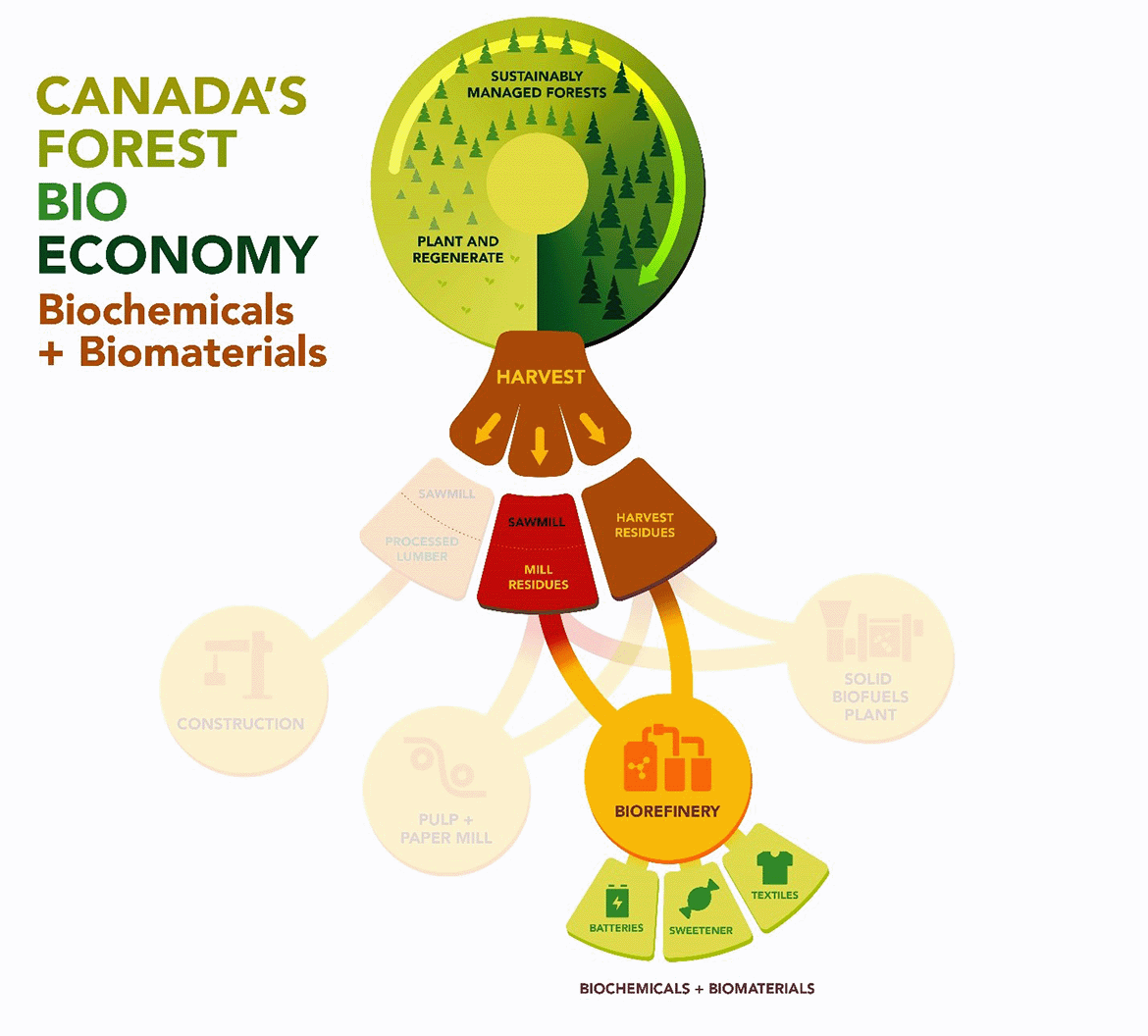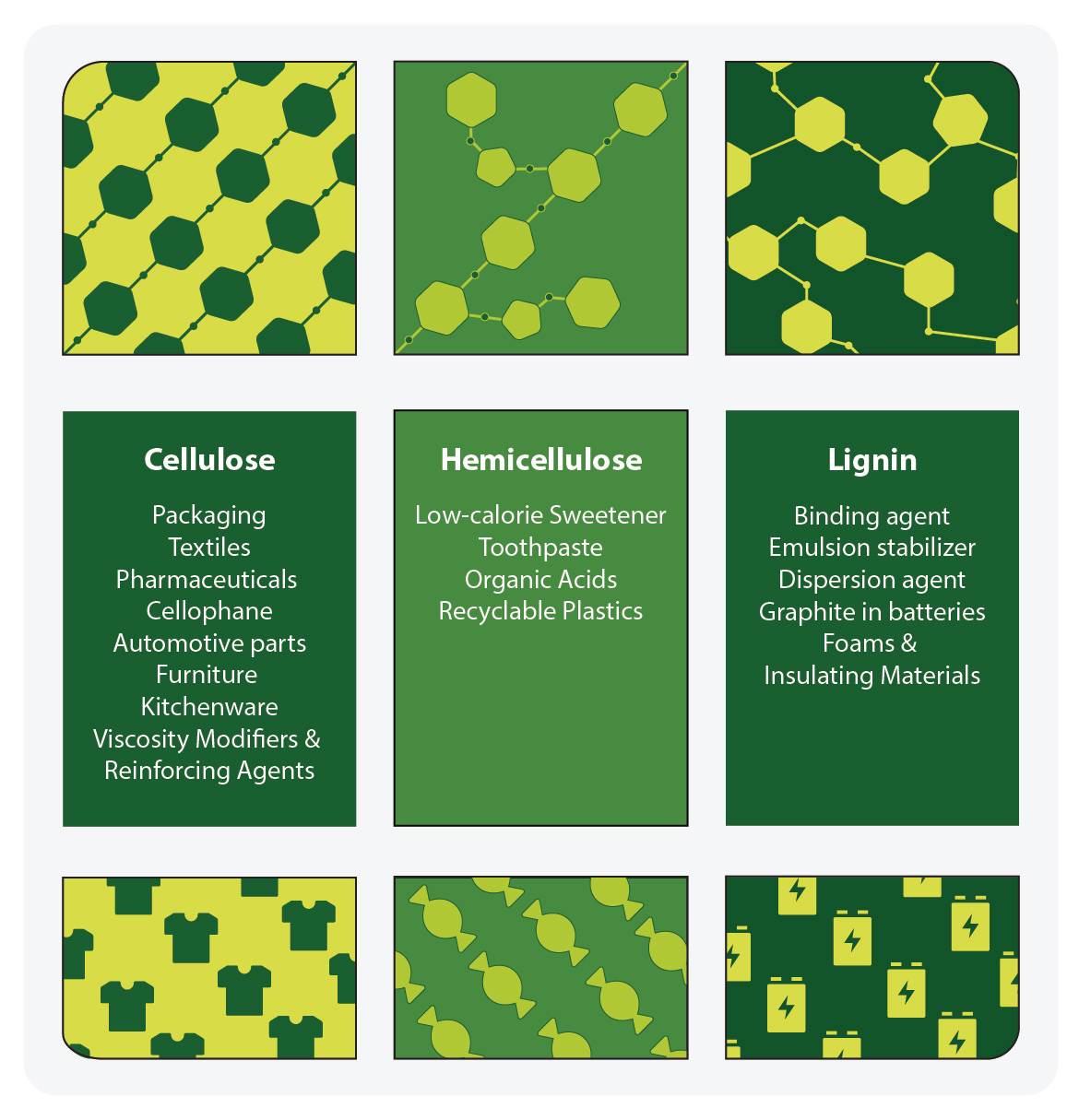Biomaterials are manufactured from biomass; recently living organisms, including plants, trees, animal by-products or microorganisms.
Biomass can be broken down into its chemical components using thermal, chemical or biological processes in a biorefinery, and then used to manufacture low-carbon renewable alternatives for everyday consumer products, such as packaging, textiles, adhesives, and electronics.

Text version
Canada's forest bioeconomy - Biochemicals and biomaterials
This image illustrates how biochemicals and biomaterials are manufactured within Canada’s forest bioeconomy.
The image begins with sustainably managed forests at the top followed by harvesting activities on the level below. The left side of the image, which includes lumber manufactured at sawmills to be used in construction, is faded out to indicate that this aspect of the cascading value chain is not relevant to the making of biochemicals and biomaterials. Meanwhile, sawmill residuals (e.g., sawdust, wood chips, bark), and harvesting residues (e.g., treetops, branches) are shown in full colour, as these residues are sent to biorefineries to manufacture an array of products such as batteries, sweeteners and textiles. The pathways from these residues to pulp and paper mills and solid biofuel plants is also faded out.
Biomaterials from forest biomass
Forest biomass used for biomaterials comes from several sources, including:
- Sustainable forest management by-products and other harvesting waste:
- Typically includes branches, treetops and other parts of a tree left over from harvesting or sustainable forest management practices.
- Sometimes includes trees that cannot be used for other purposes such as trees damaged from pest infestations (e.g. mountain pine beetle) or forest fires.
- Forest product manufacturing byproducts:
- Typically includes wood chips and sawdust left over from forest product manufacturing (e.g., sawdust from lumber production).
- Post-consumer wood waste:
- Typically includes wood waste from the construction industry (e.g., demolition materials), household and commercial waste (e.g., wooden furniture) and factories or warehouses (e.g., pallets, crates).
Biomaterials derived from these types of forest biomass are typically made from the following three main chemical compounds found in wood:
- Cellulose: Organic fibers that make up about 40-45% of a tree
- Hemicellulose: Organic fibres that bind cellulosic fibres together and that make up about 30% of a tree
- Lignin: A glue-like compound that helps to keep cellulose and hemicellulose together, forming the structure of the tree. It makes up about 25-35% of a tree.

Text version
This picture illustrates the process of breaking down a layered structure into its individual components of lignocellulosic biomass. On the left, there’s a stack of layers, each with a wavy, intertwined pattern. Arrows point to the right, showing how the layers are separated into simpler forms: a straight line to cellulose, a wavy line to hemicellulose, and a bolder straight line to lignin.
These compounds can be used to manufacture a range of products, as illustrated in the following table:

Text version
Canada’s forest bioeconomy: Biochemicals and biomaterials
Lignocellulosic biomass
Cellulose:
- packaging
- textiles
- pharmaceuticals
- cellophane
- automotive parts
- furniture
- kitchenware
- viscosity modifiers
- reinforcing agents
Hemicellulose:
- low-calorie sweetener
- toothpaste
- organic acids
- recyclable plastics
Lignin:
- binding agent
- emulsion stabilizer
- dispersion agent
- graphite in batteries
- foams
- insulating materials
When designed properly, biomaterials can also be reused, recycled and composted; extending their lifespan and supporting climate change mitigation, reducing pollution and biodiversity loss, and improving natural resource management.
Biomaterial opportunities in Canada
Biomaterials are expected to make up 20% of the total supply of materials by 2050, with a significant portion expected to come from compounds found in forest biomass. Many of these biomaterials can immediately replace other carbon intensive materials.
This provides significant opportunity for forest-based biomaterials in Canada to support growing demand domestically and internationally.
For more information on how Canada is supporting the development of biomaterials check out Canada’s forest bioeconomy opportunities webpage.